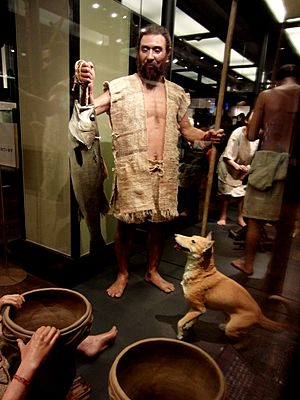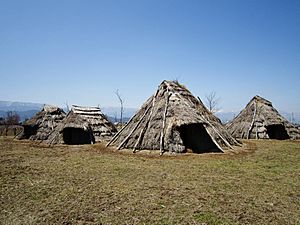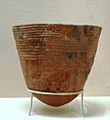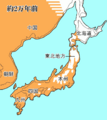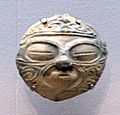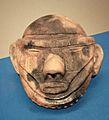Jōmon period facts for kids
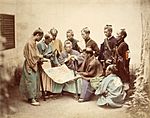 |
|---|
|
The Jōmon period was a very long time in Japan's ancient past. It lasted from about 14,000 to 300 years before the Common Era (BCE). During this time, people in Japan lived by hunting and gathering food. They developed a rich and complex way of life.
The name "Jōmon" means "cord-marked." An American expert, Edward S. Morse, found pieces of pottery in 1877. He noticed they had patterns made by pressing cords into the wet clay. He then translated this idea into Japanese as jōmon.
The Jōmon people made many useful and beautiful things. They created tools and jewelry from bone, stone, shells, and antlers. They also made pottery figures and pots, and even special items covered in lacquerware.
Their way of life is sometimes compared to ancient cultures in other parts of the world, like the Pacific Northwest of North America or the Valdivia culture in Ecuador. This is because these groups also developed complex societies while mainly hunting and gathering, with only a little bit of farming.
Ancient Stories of Japan
Some of Japan's oldest stories about how the country began go back to the Jōmon period. However, these stories don't quite match what archaeologists have found about the Jōmon people.
For example, February 11, 660 BCE, is the traditional date when Emperor Jimmu supposedly founded Japan. But this version of history comes from Japan's first written books, the Kojiki and Nihon Shoki. These books were written much later, between the 6th and 8th centuries CE, after Japan started using Chinese writing.
Some parts of modern Japanese culture might have started during the Jōmon period. This could be because people from northern Asia and the southern Pacific areas mixed with the Jōmon people. These early influences might include the beginnings of Shinto (Japan's traditional religion), some marriage customs, building styles, and skills like making lacquerware, special bows, metal items, and glass.
See Also
Images for kids
-
A reconstructed Jōmon village at the Sannai-Maruyama Site in Aomori Prefecture.
-
Early Jōmon pottery (14,000–8,000 BCE) at the Tokyo National Museum, Japan.
-
Azuki beans were grown in southern Jōmon Japan, as well as in southern China and Bhutan.
-
A Jōmon clay mask, similar to masks found in the Amur region.
-
The Magatama is a famous type of jewelry from Jōmon period Japan. It was also found in the Korean Peninsula and Northeast Asia.
-
Reconstructed Jōmon period houses in Aomori Prefecture.
-
A Jōmon period clay figure from the Yamanashi Prefecture.
-
Late Jōmon clay statue, Kazahari I, Aomori Prefecture, 1500–1000 BCE.
-
Late Jōmon clay head, Shidanai, Iwate Prefecture, 1500–1000 BCE.
See also
 In Spanish: Período Jōmon para niños
In Spanish: Período Jōmon para niños


